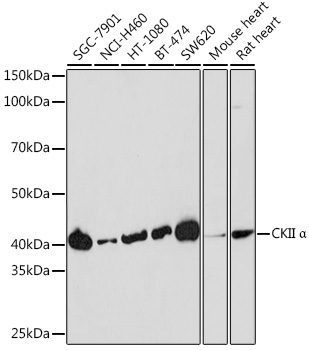Cell Death Antibodies 2
Anti-CKII Alpha Antibody (CAB19683)
- SKU:
- CAB19683
- Product Type:
- Antibody
- Reactivity:
- Human
- Reactivity:
- Mouse
- Reactivity:
- Rat
- Host Species:
- Rabbit
- Isotype:
- IgG
- Research Area:
- Cell Death
Description
| Antibody Name: | Anti-CKII Alpha Antibody |
| Antibody SKU: | CAB19683 |
| Antibody Size: | 20uL, 50uL, 100uL |
| Application: | WB |
| Reactivity: | Human, Mouse, Rat |
| Host Species: | Rabbit |
| Immunogen: | A synthesized peptide derived from human CKII Alpha. |
| Application: | WB |
| Recommended Dilution: | WB 1:500 - 1:2000 |
| Reactivity: | Human, Mouse, Rat |
| Positive Samples: | SGC-7901, NCI-H460, HT-1080, BT-474, SW620, Mouse heart, Rat heart |
| Immunogen: | A synthesized peptide derived from human CKII Alpha. |
| Purification Method: | Affinity purification |
| Storage Buffer: | Store at -20°C. Avoid freeze / thaw cycles. Buffer: PBS with 0.02% sodium azide, 0.05% BSA, 50% glycerol, pH7.3. |
| Isotype: | IgG |
| Sequence: | Email for sequence |
| Gene ID: | 1457 |
| Uniprot: | P68400 |
| Cellular Location: | Nucleus |
| Calculated MW: | 45kDa |
| Observed MW: | 45KDa |
| Synonyms: | CK2A1, CKII, CSNK2A3, OCNDS, CKII alpha, CSNK2A1, Cka1, Cka2 |
| Background: | Casein kinase II is a serine/threonine protein kinase that phosphorylates acidic proteins such as casein. It is involved in various cellular processes, including cell cycle control, apoptosis, and circadian rhythm. The kinase exists as a tetramer and is composed of an alpha, an alpha-prime, and two beta subunits. The alpha subunits contain the catalytic activity while the beta subunits undergo autophosphorylation. The protein encoded by this gene represents the alpha subunit. While this gene is found on chromosome 20, a related transcribed pseudogene is found on chromosome 11. Three transcript variants encoding two different proteins have been found for this gene. [provided by RefSeq, Jul 2014] |
| UniProt Protein Function: | CK2A1: an ubiquitous protein kinase of the CK2 family. Exists as a tetramer composed of two catalytic subunits, alpha and alpha-prime, and two regulatory beta subunits. The beta subunits undergo autophosphorylation. The isoforms are rarely specified in publications. Two splice variant isoforms have been found. Participates in Wnt signaling. Phosphorylates E2 ubiquitin conjugating enzyme UBC3B inducing its interaction with beta-TRCp and enhancing beta-catenin degradation. May control IkB-alpha and p27Kip1 degradation. component of a CK2-SPT16-SSRP1 complex composed of SSRP1, PT16 CK2-A1, CK2-A2 and CK2-B the complex associating following UV irradiation. Interacts with RNPS1. Mouse transgene causes mammary gland hyperplasia and lymphoma, and activation by bovine parasites leads to fatal lymphoproliferation. Expression and activity are elevated in lung tumors and breast tumors. Antisense drives apoptosis of tumor cell lines and xenografts. Involved in DNA break repair by phosphorylation of scaffold protein XRCC1, phosphorylation of BRCA1, and phosphorylation of p53 in response to UV irradiation. Drosophila CK2 (Timekeeper) is involved in circadian regulation. Phosphorylates and binds to a major component of the inclusion bodies seen in Parkinson?s patients. Inhibitors: 4,5,6,7-tetrabromobenzotriazole (TBB). |
| UniProt Protein Details: | Protein type:EC 2.7.11.1; Kinase, protein; Protein kinase, Ser/Thr (non-receptor); Protein kinase, Other; Other group; CK2 family Chromosomal Location of Human Ortholog: 20p13 Cellular Component: Sin3 complex; plasma membrane; PcG protein complex; NuRD complex; cytosol; nucleus Molecular Function:protein serine/threonine kinase activity; protein binding; protein N-terminus binding; Hsp90 protein binding; ATP binding Biological Process: axon guidance; Wnt receptor signaling pathway; transcription, DNA-dependent; rhythmic process; negative regulation of caspase activity; signal transduction; positive regulation of cell growth; protein amino acid phosphorylation; regulation of transcription, DNA-dependent; positive regulation of cell proliferation; positive regulation of protein catabolic process; mitotic cell cycle; positive regulation of Wnt receptor signaling pathway |
| NCBI Summary: | Casein kinase II is a serine/threonine protein kinase that phosphorylates acidic proteins such as casein. It is involved in various cellular processes, including cell cycle control, apoptosis, and circadian rhythm. The kinase exists as a tetramer and is composed of an alpha, an alpha-prime, and two beta subunits. The alpha subunits contain the catalytic activity while the beta subunits undergo autophosphorylation. The protein encoded by this gene represents the alpha subunit. While this gene is found on chromosome 20, a related transcribed pseudogene is found on chromosome 11. Three transcript variants encoding two different proteins have been found for this gene. [provided by RefSeq, Jul 2014] |
| UniProt Code: | P68400 |
| NCBI GenInfo Identifier: | 55977123 |
| NCBI Gene ID: | 1457 |
| NCBI Accession: | P68400.1 |
| UniProt Secondary Accession: | P68400,P19138, P20426, Q14013, Q5U065, B4DYS6, D3DVV8 |
| UniProt Related Accession: | P68400,Q8NEV1 |
| Molecular Weight: | 391 |
| NCBI Full Name: | Casein kinase II subunit alpha |
| NCBI Synonym Full Names: | casein kinase 2, alpha 1 polypeptide |
| NCBI Official Symbol: | CSNK2A1 |
| NCBI Official Synonym Symbols: | CKII; CK2A1; CSNK2A3 |
| NCBI Protein Information: | casein kinase II subunit alpha; CK II alpha 3; protein kinase CK2; CK2 catalytic subunit alpha; casein kinase II alpha 1 subunit; casein kinase II alpha 1 polypeptide pseudogene |
| UniProt Protein Name: | Casein kinase II subunit alpha |
| Protein Family: | Casein kinase |
| UniProt Gene Name: | CSNK2A1 |
| UniProt Entry Name: | CSK21_HUMAN |







